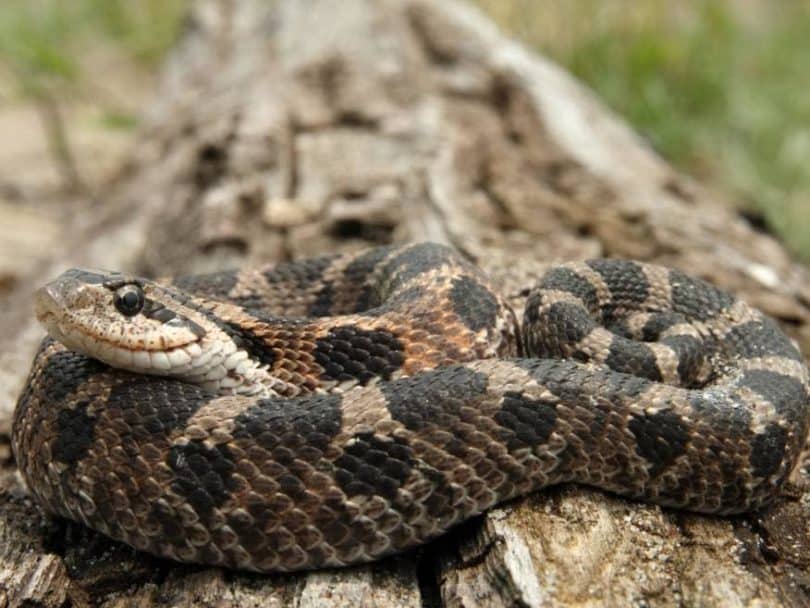Finding a snake in Alabama isn’t a difficult task. With the variety of terrains the state has to offer, almost anywhere you go, you’ll find something slithering around. Like most states, Alabama has a mixture of both non-venomous and venomous snakes. In total, Alabama plays host to 50 different species of snake. Due to the mix of terrains throughout the state, it’s quite common to see these snakes enjoying their habitat.
The real question most people like to ask is how many venomous snakes are in Alabama. Luckily for you, there are only six species of poisonous snake found in this gorgeous state.
If you live in Alabama and want to stay educated on what snakes you may encounter or are simply a snake enthusiast who wants to know all there is to know about snakes in North America, this list is what you’re looking for. Read on below to meet 12 of these species, including Alabama’s venomous snakes, and learn what to look for when visiting this great state.

The 12 Snakes Found in Alabama
The 6 Venomous Snakes Found in Alabama
Up first, let’s take a look at the venomous snakes in Alabama. As you will see, several of these species are far more common to encounter than others. Two venomous snakes who call Alabama home are even considered endangered, while the copperhead is one of the most encountered.
1. Copperhead
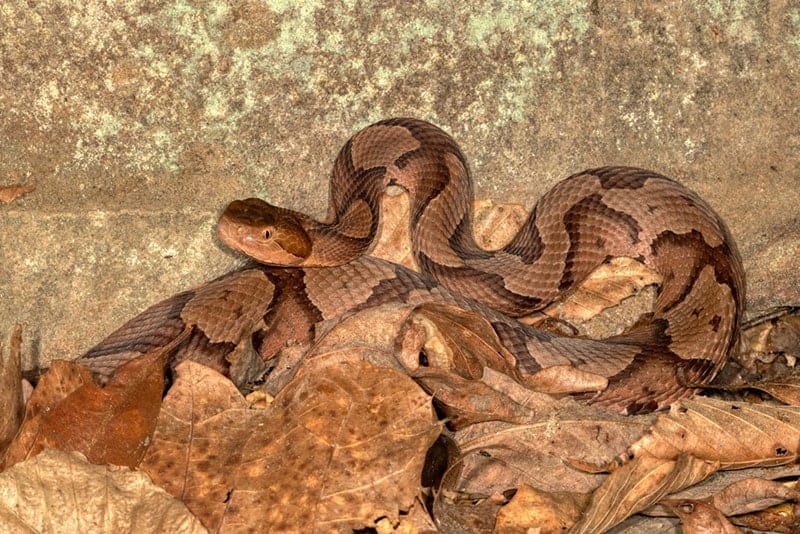
| Species: | Agkistrodon contortrix |
| Longevity: | 18 years |
| Good to own as a pet?: | No |
| Legal to own?: | No |
| Adult size: | 61 – 90 cm |
| Diet: | Carnivorous |
The copperhead is the most encountered venomous snake in the state of Alabama. These venomous snakes are found in most regions of the state and are in no danger of conservation concerns. They are known for their reddish coloring, dark crossbands, and hourglass designs. Copperheads are carnivores and live quite well eating mice, small snakes, small birds, and lizards. Copperheads can also become victims and are often hunted by the kingsnake, racer, and cottonmouth. These snakes are known as ambush hunters and have been noted with aggressive tendencies when approached.
2. Cottonmouth
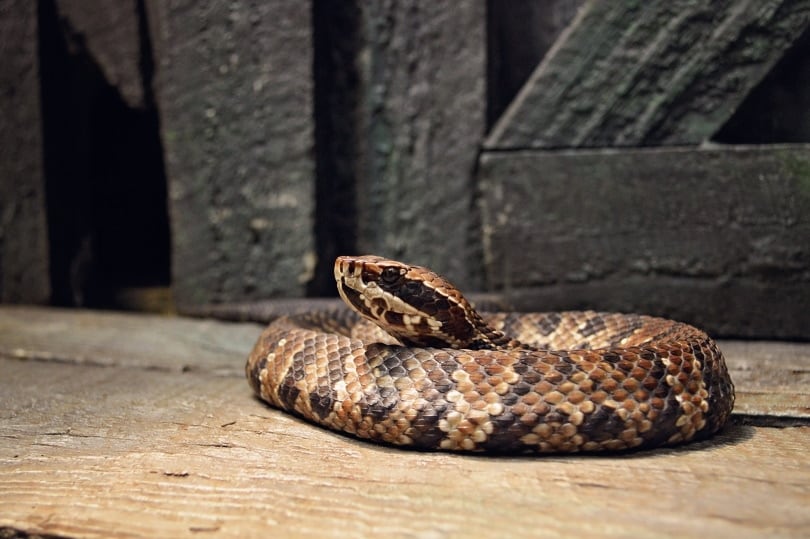
| Species: | Agkistrodon piscivorus |
| Longevity: | Less than 10 years |
| Good to own as a pet?: | No |
| Legal to own?: | No |
| Adult size: | 61 – 122 cm |
| Diet: | Carnivorous |
The cottonmouth is found throughout the state of Alabama but is most common in the Coastal Plain Swamps. These are the only venomous water snakes in North America and are best known for their large size and white mouths. The cottonmouth thrives quite well in aquatic areas by feeding on fish, turtles, small snakes, baby alligators, and even lizards. Adult cottonmouths do not have any natural predators, but young snakes may be preyed upon by otters, raccoons, and large birds. When threatened, these snakes are known to vibrate their tails as a warning before striking.
3. Timber Rattlesnake
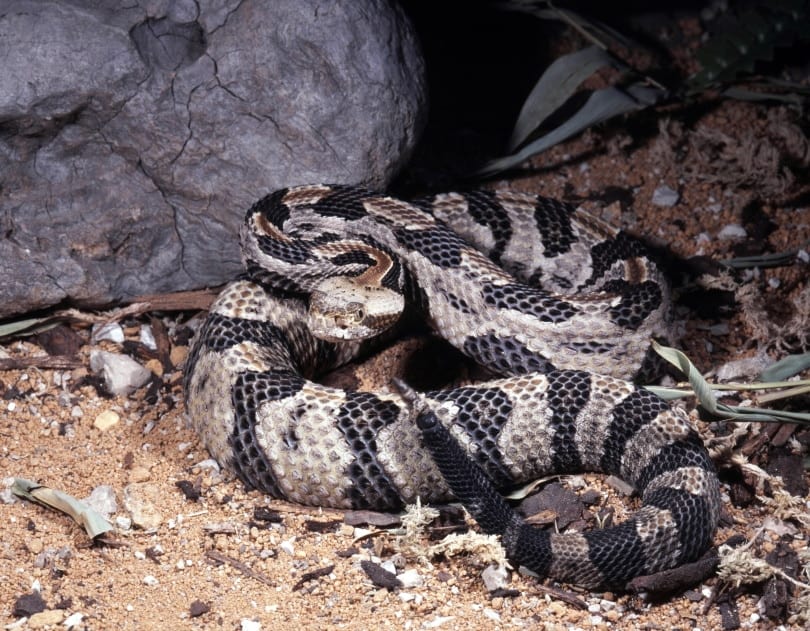
| Species: | Crotalus horridus |
| Longevity: | 30 years |
| Good to own as a pet?: | No |
| Legal to own?: | No |
| Adult size: | 76 – 152 cm |
| Diet: | Carnivorous |
The timber rattlesnake is found throughout most of Alabama but due to habitat issues, they are now gone from areas they once populated. This snake is a heavy-bodied creature most famous for its tan rattle that alerts people and prey to their strike. Varying in colors, the timber rattlesnake has crossbands with a reddish-colored dorsal stripe. These snakes prefer a diet of small rodents, chipmunks, shrews, and even squirrels. Bobcats, hawks, and even coyotes are among the predators who will attack and eat young timber rattlesnakes.
4. Pigmy Rattlesnake

| Species: | Sistrurus miliarius |
| Longevity: | 20+ years |
| Good to own as a pet?: | No |
| Legal to own?: | No |
| Adult size: | 38.1 – 63.5 cm |
| Diet: | Carnivorous |
The pigmy rattlesnake is on the decline in the state of Alabama. Rarely seen over the past few years, the few visuals have taken place in the extreme southern parts of the state. Mostly gray in coloration, these snakes are quite small and have tiny rattles that can barely be heard. These snakes most commonly eat mice, lizards, small birds, and frogs. Hawks, owls, raccoons, and other snakes are the pigmy rattlesnake’s natural enemies and may be contributing to their decrease in numbers.
5. Eastern Coral Snake
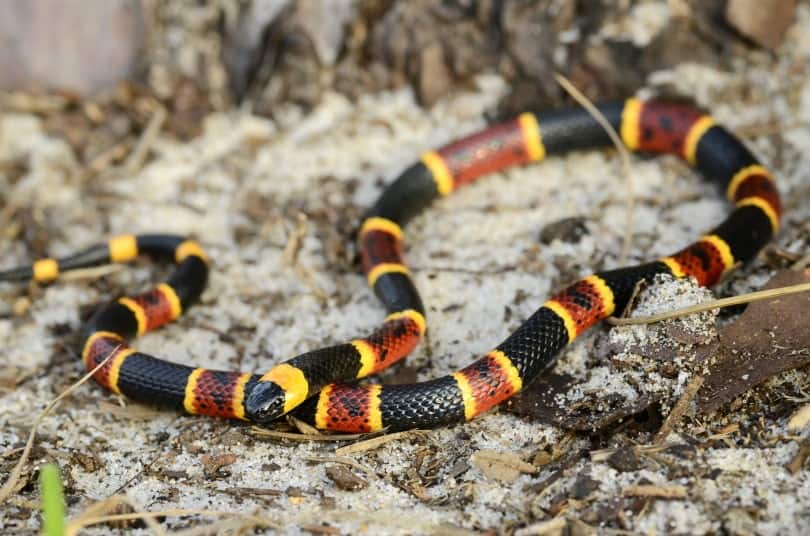
| Species: | Micrurus fulvius |
| Longevity: | 7 years |
| Good to own as a pet?: | No |
| Legal to own?: | No |
| Adult size: | 109 cm |
| Diet: | Carnivorous |
The eastern coral snake is rapidly declining in the state of Alabama and may be considered endangered. These snakes are best known for their red, black, and yellow-colored bands. Known to eat mostly small snakes, mice, and lizards, the coral snake finds itself falling victim to most other snakes in the state. These snakes aren’t considered aggressive but are known for having the most toxic venom of any snake in North America.
6. Eastern Diamondback Rattlesnake

| Species: | Crotalus adamanteus |
| Longevity: | 15 to 20 years |
| Good to own as a pet?: | No |
| Legal to own?: | No |
| Adult size: | 84 – 183 cm |
| Diet: | Carnivorous |
The eastern diamondback rattlesnake is another that is now extremely rare in the state of Alabama. Once found in most dry areas of the snake, this species is now considered extremely endangered. Known for the diamond patterns on their back and the rattles on their tails, this snake is a pit viper that feeds on most small creatures. Large birds, coyotes, and bobcats look at these snakes as a food source when possible.

The 4 Non-Venomous Snakes in Alabama
7. Black Racer
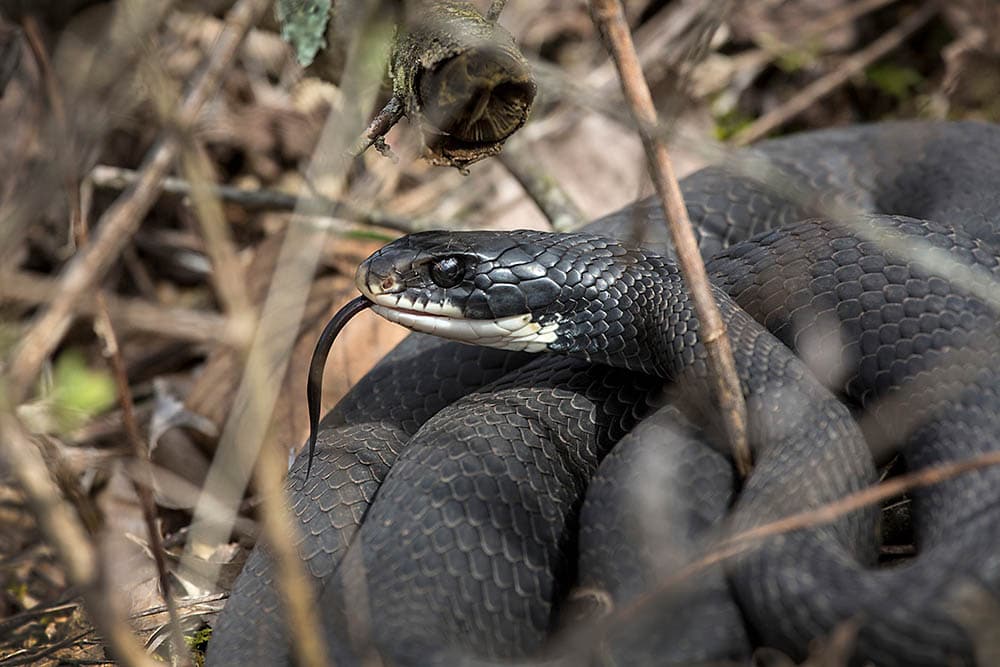
| Species: | Coluber constrictor |
| Longevity: | 10 years |
| Good to own as a pet?: | No |
| Legal to own?: | Yes |
| Adult size: | 51 – 160 cm |
| Diet: | Carnivorous |
The black racer is known for its slender body and coloring. Mostly black, these snakes may have a slightly gray color on their bellies. This species is easy to find throughout the state, but enjoy staying in areas where terrains meet such as baselines of swamps. The black racer is not a picky eater and will feast on mice, lizards, small birds, and almost anything it can get. This snake is only a day hunter, however, and is rarely seen on the prowl at night. The most feared enemy of this snake are birds of prey who are known to add the black racer to their meals.
8. Eastern Hognose Snake
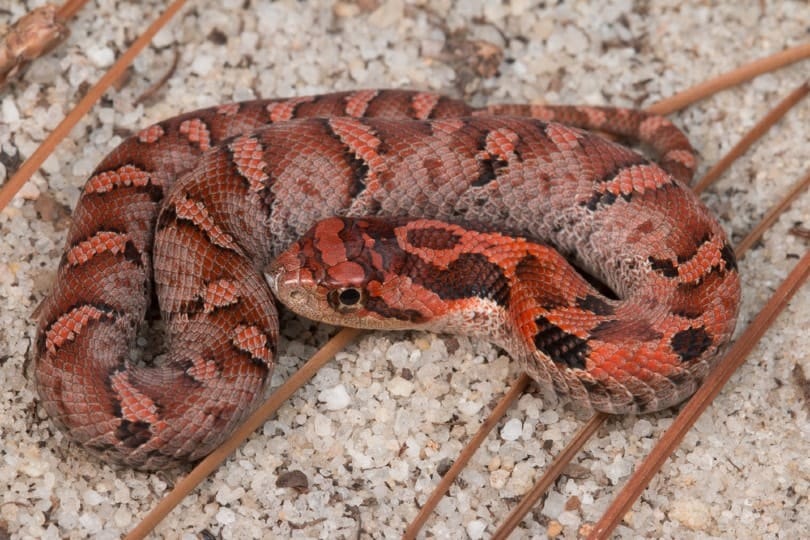
| Species: | Heterodon platirhinos |
| Longevity: | 12 years |
| Good to own as a pet?: | Yes |
| Legal to own?: | Yes |
| Adult size: | 115 cm |
| Diet: | Carnivorous |
The eastern hognose snake, also known as the puff adder, is another species in Alabama with dwindling numbers. Ideal for life in any of the state’s terrain, these snakes prefer to feed on mostly toads and salamanders but don’t mind adding small mammals and birds to their list. The eastern hognose snake can vary in colors with most being mostly black, grey, or olive color. These snakes are also well-loved by snake enthusiasts who consider them a great pet to own. In the wild, these snakes may fall prey to large birds and other snakes.
9. Eastern Milk Snake
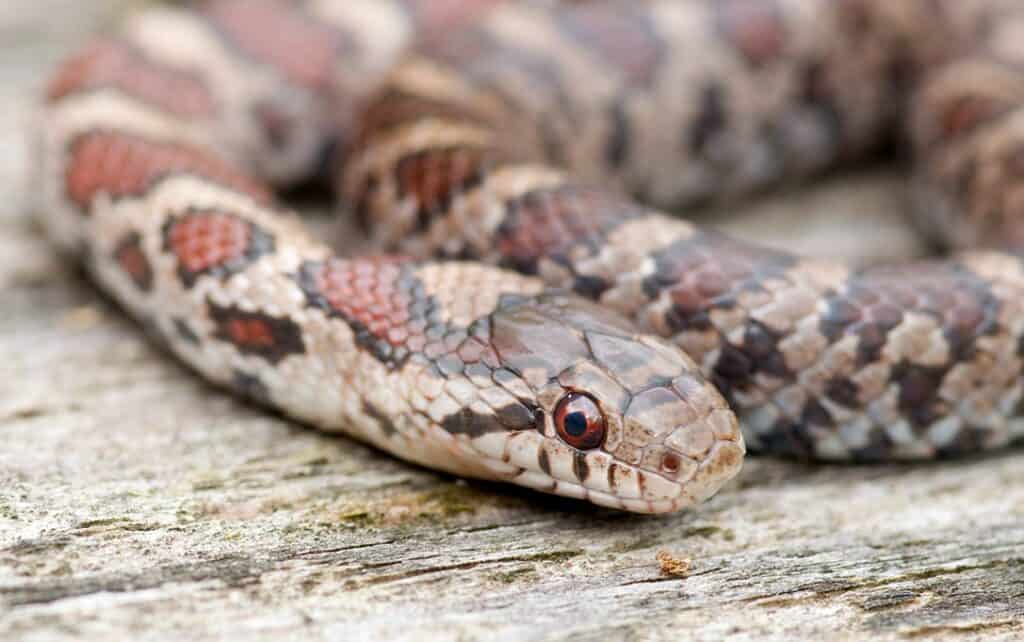
| Species: | Lampropeltis triangulum Triangulum |
| Longevity: | 12 years |
| Good to own as a pet?: | Yes |
| Legal to own?: | Yes |
| Adult size: | 35.5 – 175 cm |
| Diet: | Carnivorous |
The background color of the eastern milk snake features a gray or black while reddish-brown bands cover the rest of the body. This snake is best-known for enjoying the northern areas of Alabama but has been encountered far less over the past few years. The diet of the eastern milk snake consists mostly of small animals, preferably mice. Another favorite of snake owners, this snake’s longevity normally increases to 15 to 20 years when in captivity and well-cared for. The natural threats to this snake include raccoons, skunks, and opossums.
10. Gray Rat Snake
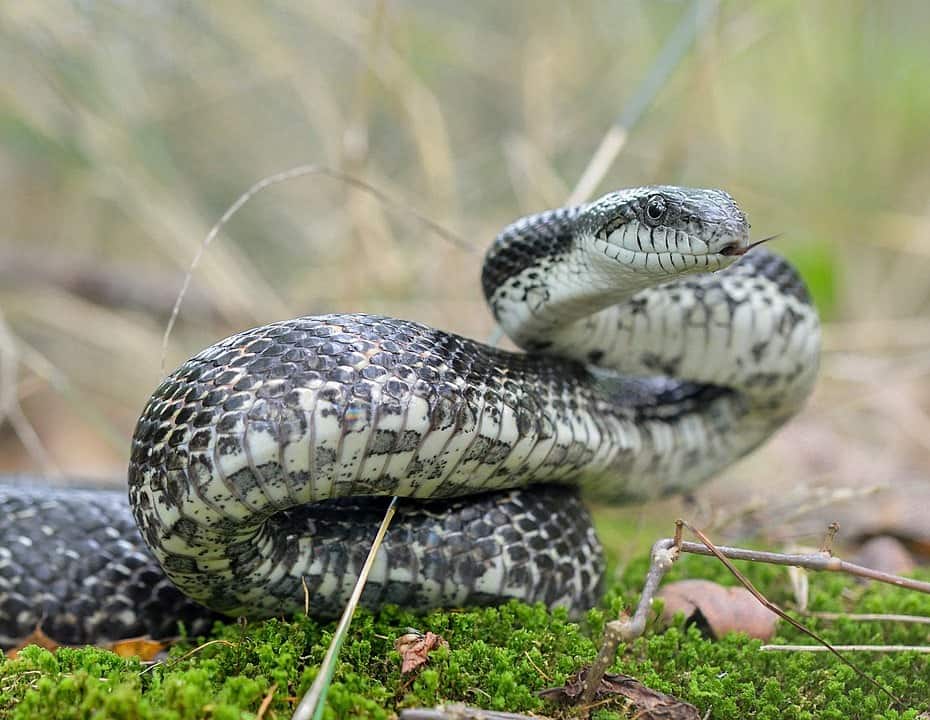
| Species: | Pantherophis spiloides |
| Longevity: | 15 years |
| Good to own as a pet?: | Yes |
| Legal to own?: | Yes |
| Adult size: | 99 – 183 cm |
| Diet: | Carnivorous |
Both the gray and black rat snake is found in Alabama, but the gray is far more common. As the name says, this stout snake is gray in color with gray blotches covering its body. Although found throughout the state, this snake prefers life in eastern Alabama, feasting mostly on mice and eggs. Hawks and foxes are this snake’s biggest enemies.

The 2 Non-Venomous Water Snakes in Alabama
11. Southern Water Snake
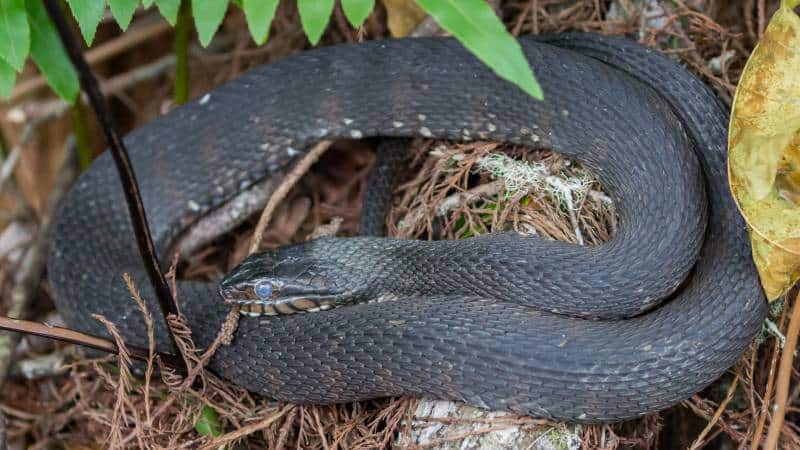
| Species: | Nerodia fasciata |
| Longevity: | 15 years |
| Good to own as a pet?: | Yes |
| Legal to own?: | Yes |
| Adult size: | 56 – 101 cm |
| Diet: | Carnivorous |
The southern water snake is fairly common in Alabama but prefers life on the Southern Coastal Plain. Preferring life near the water, this snake is brown with lighter bands running the length of its body. These water snakes feed on aquatic creatures such as small fish, tadpoles, and frogs. These snakes are considered great pets and live up to 9 years in captivity, but little is known about their longevity in the wild. Snapping turtles are one of the biggest threats to these snakes and often make them a food source.
12. Queen Snake
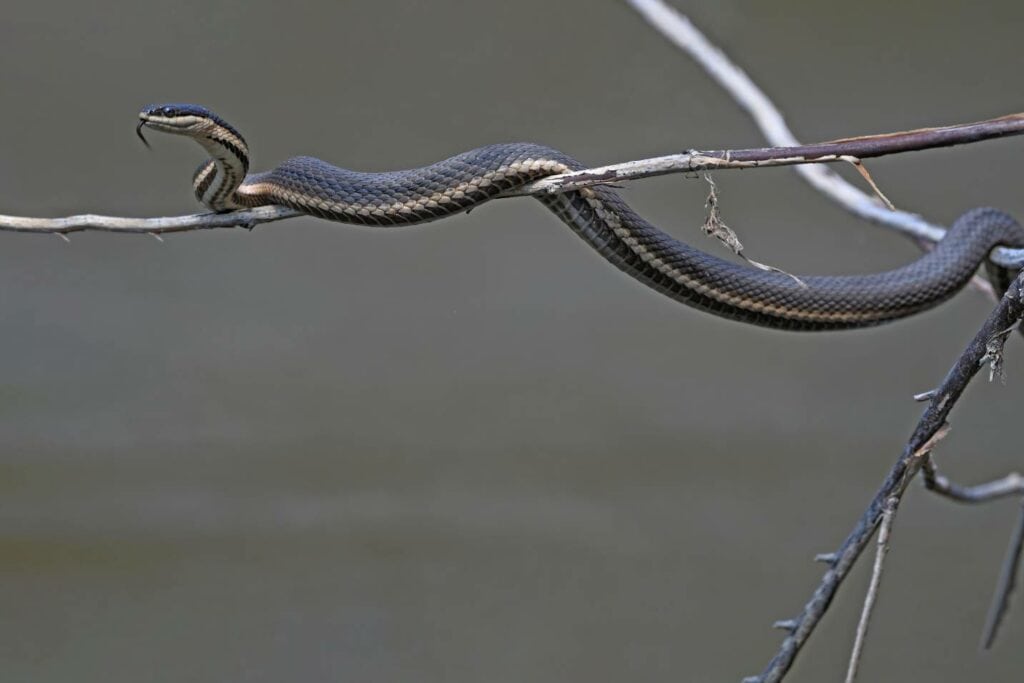
| Species: | Regina septemvittata |
| Longevity: | 19 years (in captivity) |
| Good to own as a pet?: | Yes |
| Legal to own?: | Yes |
| Adult size: | 34 – 92.2 cm |
| Diet: | Carnivorous |
The queen snake is quite small and mostly appears brown or olive. This snake is fairly common in Alabama but appears to have dwindling numbers in the southern areas of the state. These water snakes prefer smaller bodies of water and spend most of their time feeding on crayfish. Due to their size, the queen snake falls prey to most predatory animals in the area including crayfish, their preferred prey.

How to Protect Yourself Against Venomous Snakes
Yes, Alabama is a gorgeous state that many people find themselves wanting to explore. Unfortunately, with these six venomous snakes on the prowl, you need to know how to keep yourself safe. Here are a few tips to take along with you on your travels throughout Alabama.
- Never wear open-toed shoes when walking through the woods
- Wear pants when possible, even if it’s hot outside
- Keep a visual of at least 3 to 5 feet ahead of you at all times
- Avoid placing your hands or feet in areas where you cannot see
- When encountering a snake, move away slowly, especially if you are unaware of the species

Conclusion
Now that you’ve met a few of Alabama’s snakes, you can better prepare yourself for life in this state. Keep in mind, when venturing into the wilderness, swamps, or other areas where snakes are common, stay aware, listen, and keep your eyes peeled. As you’ve seen with many of the snakes above, they could be anywhere, just waiting to say hello.
Also see:
- Corn Snake vs. Copperhead: Key Differences (With Pictures)
- Do Snakes Like Being Pet? Vet-Reviewed Info You Need To Know!
Featured Image Credit by Ryan M. Bolton, Shutterstock
